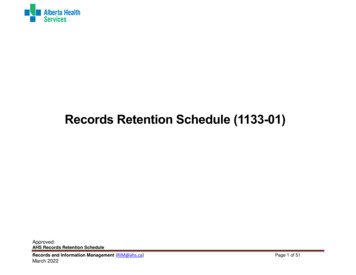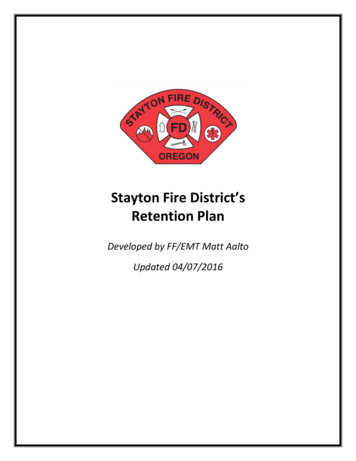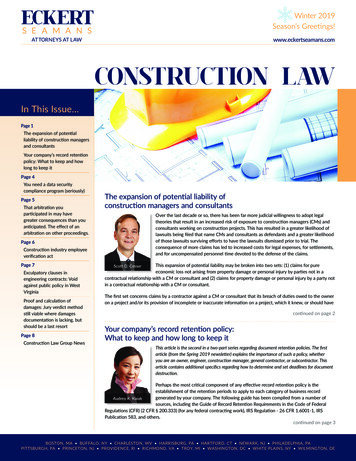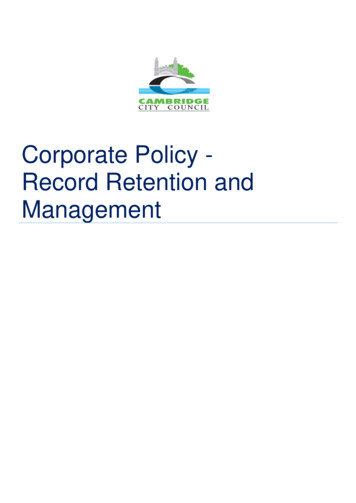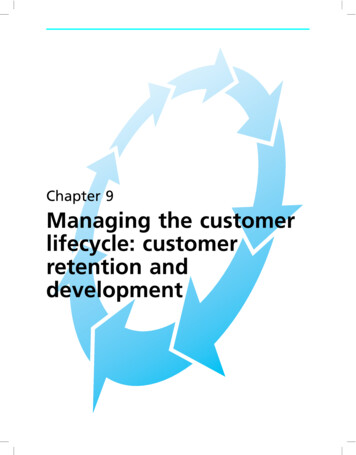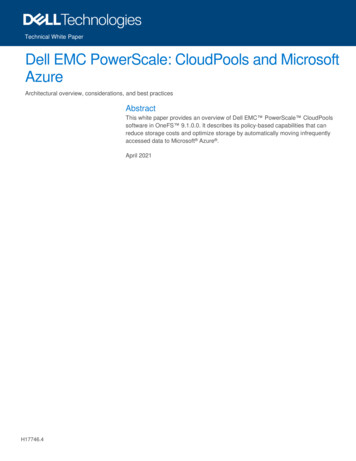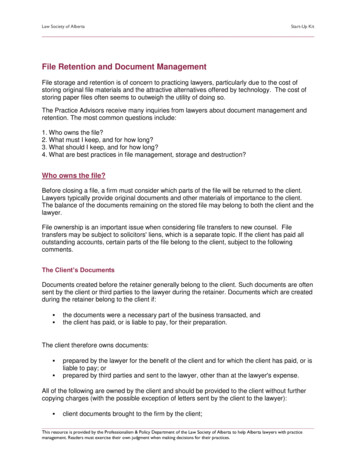
Transcription
Law Society of AlbertaStart-Up KitFile Retention and Document ManagementFile storage and retention is of concern to practicing lawyers, particularly due to the cost ofstoring original file materials and the attractive alternatives offered by technology. The cost ofstoring paper files often seems to outweigh the utility of doing so.The Practice Advisors receive many inquiries from lawyers about document management andretention. The most common questions include:1. Who owns the file?2. What must I keep, and for how long?3. What should I keep, and for how long?4. What are best practices in file management, storage and destruction?Who owns the file?Before closing a file, a firm must consider which parts of the file will be returned to the client.Lawyers typically provide original documents and other materials of importance to the client.The balance of the documents remaining on the stored file may belong to both the client and thelawyer.File ownership is an important issue when considering file transfers to new counsel. Filetransfers may be subject to solicitors' liens, which is a separate topic. If the client has paid alloutstanding accounts, certain parts of the file belong to the client, subject to the followingcomments.The Client’s DocumentsDocuments created before the retainer generally belong to the client. Such documents are oftensent by the client or third parties to the lawyer during the retainer. Documents which are createdduring the retainer belong to the client if: the documents were a necessary part of the business transacted, andthe client has paid, or is liable to pay, for their preparation.The client therefore owns documents: prepared by the lawyer for the benefit of the client and for which the client has paid, or isliable to pay; orprepared by third parties and sent to the lawyer, other than at the lawyer's expense.All of the following are owned by the client and should be provided to the client without furthercopying charges (with the possible exception of letters sent by the client to the lawyer): client documents brought to the firm by the client;This resource is provided by the Professionalism & Policy Department of the Law Society of Alberta to help Alberta lawyers with practicemanagement. Readers must exercise their own judgment when making decisions for their practices.
Law Society of AlbertaStart-Up Kit originals of all documents prepared for the client;copies of all documents prepared by the lawyer for which the client has paid, includingdraft copies of documents;copies of letters received by the lawyer, some of which may be paid for by the client;copies of letters of instruction from the client to the lawyer;copies of letters from the lawyer to third parties kept in the client file;originals of letters from the lawyer to the client, though these would be sent to the clientin the normal course;copies of case law;notes of telephone calls, meetings or interviews;briefs and memoranda of law where preparation was paid by the client;documents created in preparation for a hearing or trial, such as briefs, trial books andbooks of documents;letters received by the lawyer from third parties;copies of vouchers and receipts for disbursements made by the lawyer on behalf of theclient;expert reports;discovery and trial transcriptsMore recently, some lawyers have questioned whether the former firm is obliged to provideelectronic copies of emails and drafts of documents to the client or new counsel, along with theclient’s paper file. In the Practice Advisors’ collective opinion, the digital file materials form partof the work product for which the client has already paid and should be provided. New counselshould not be expected, for example, to retype an entire agreement when the former firm hasrefused to provide an electronic version for editing.The Lawyer’s DocumentsDocuments created during the retainer belong to the lawyer if: the lawyer was under no duty to prepare them;the documents were not prepared for the benefit of the client;the client cannot be regarded as liable to pay for them.Documents properly belonging to the lawyer include: documents sent to the lawyer in circumstances where ownership was intended to passto the lawyer;original letters sent by client;copies of all original correspondence;copies of original documents or correspondence belonging to the client, and copied atthe lawyer's expense;working notes or summaries, lawyer’s notes regarding submissions to court;inter-office memos;time entries;accounting records;original receipts and disbursement vouchers;notes and other documents prepared for the lawyer's benefit or protection and at thelawyer's expense.This resource is provided by the Professionalism & Policy Department of the Law Society of Alberta to help Alberta lawyers with practicemanagement. Readers must exercise their own judgment when making decisions for their practices.
Law Society of AlbertaStart-Up KitWhat must you keep?The Rules of the Law SocietyLawyers’ obligations to maintain records are addressed in the Rules of the Law Society ofAlberta, as follows:119.37 (1) Except as otherwise authorized by the Executive Director, a law firm shall:(a) maintain its financial records in a safe and secure location;(b) maintain its most recent 2 years of financial records at its principalplace of practice in Alberta;(c) upon completion and closing of a client file, place a copy of the clienttrust ledger card on the client file;(d) retain its trust ledger accounts referred to in rule 119.36(4)(b) and (c)for at least the 10-year period following the fiscal year of the law firm inwhich the trust ledger account was closed;(e) retain all other financial records referred to in rule 119.36, for at leastthe 10-year period following the fiscal year of the law firm in which therecords came into existence;(f) retain such parts of the files of the law firm, relating to the affairsof clients or former clients of the law firm, as are necessary tosupport the prescribed financial records for at least the 10-yearperiod following the fiscal year of the law firm in which the file wasclosed. [emphasis added](2) A law firm must not give up possession of any financial records and client filesof the law firm relating to the affairs of clients or former clients of the law firm to aperson other than a lawyer, unless the law firm retains or makes a copy of suchparts of the file as are necessary to support the prescribed financial records,which copy must be deemed to be an original for the purposes of the Act and theRules.The rule requires retention of financial records for ‘ten plus’ years. This rule does not, however,create an obligation to maintain the entirety of the client’s file. The rule is focused onmaintenance of trust accounting records. It is, however, strongly recommended that lawyers donot destroy files until a minimum of ten years after a matter is complete.Also note that the client identification rules require information related to the identification andverification of clients to be stored for six years following the completion of the work for which thelawyer was retained (see Rule 118.7(1) of the Rules of the Law Society of Alberta, available at(Rules of the Law Society of Alberta).The Income Tax Act requires financial records to be maintained for six years from the lasttaxation year for which the record may be required for a determination under the Act. TheseThis resource is provided by the Professionalism & Policy Department of the Law Society of Alberta to help Alberta lawyers with practicemanagement. Readers must exercise their own judgment when making decisions for their practices.
Law Society of AlbertaStart-Up Kitrequirements should not be confused with lawyers’ file retention obligations under the Rules ofthe Law Society.The Code of ConductThe current Code of Conduct, in force February 3, 2017, provides for: Preservation of confidentiality – Rule 3.3-1Preservation of client property, including funds, wills, minute books, and all other papersand files. You are to care for client property as a careful prudent owner would, and mustobserve all relevant rules and law – Rule 3.5-1You must account for client property in your custody and, where appropriate, return it tothe client – Rules 3.5-4 and 3.5-5When withdrawing from a representation, you must provide client files to successorcounsel, subject to a lawyer’s right of lien – Rule 3.7-7You should explain fees or disbursements a client might not anticipate – Rule 3.6-1. Thiswould apply to file storage or retrieval costs.What should you keep?The Practical Realities of File StorageThe rules do not require you to keep a complete copy of the entire client file – it is, however, astrongly recommended practice, in the event you are required to defend yourself in aprofessional negligence claim or respond to a complaint. While there are, of course, no timelimitations applicable to complaints to the Law Society, civil litigation claims are subject tolimitations legislation. It is standard practice for most firms to store client files for ten yearsfollowing the end of the fiscal year in which the file was closed, in consideration of sections 3and 11 of the Limitations Act.The Limitations Act provides:3(1) Subject to section 11, if a claimant does not seek a remedial order within(a) 2 years after the date on which the claimant first knew, or in thecircumstances ought to have known,(i) that the injury for which the claimant seeks a remedial order hadoccurred,(ii)that the injury was attributable to conduct of the defendant, and(iii) that the injury, assuming liability on the part of the defendant,warrants bringing a proceeding, or(b)10 years after the claim arose,This resource is provided by the Professionalism & Policy Department of the Law Society of Alberta to help Alberta lawyers with practicemanagement. Readers must exercise their own judgment when making decisions for their practices.
Law Society of AlbertaStart-Up Kitwhichever period expires first, the defendant, on pleading this Act as a defence, isentitled to immunity from liability in respect of the claim.Section 11 provides:11 If, within 10 years after the claim arose, a claimant does not seek a remedial orderin respect of a claim based on a judgment or order for the payment of money, thedefendant, on pleading this Act as a defence, is entitled to immunity from liability inrespect of the claim.There are further qualifications on the limitation periods set forth in the Act. For example,section 4(1) states that the operation of the ten-year limitation period is suspended while adefendant fraudulently conceals an injury. The operation of a limitation applicable to anindividual under disability is also suspended during the time the claimant is disabled. There areother special provisions governing claims by minors.In reality, however, most claims and complaints are brought in the early stages. Any file thatmay give rise to a potential claim that is not statute-barred should be retained indefinitely, untilthe lawyer is able to make an assessment of his or her potential liability. If you are unsure whento destroy a file, set a date on which to review and reassess it in the future. Sound businessjudgment should be applied when deciding to destroy files, whether at or after the ten yearperiod. You may wish to be particularly cautious when minors or mentally incompetent clientsare involved.The nature of the work performed, or the “working life” of the document, must also beconsidered when deciding how long to store client files. Wills are an obvious example, as theymay not be subject to probate for a number of years after their execution. Other examples ofdocuments with an extended “working life” include mortgages, long term leases, andmatrimonial agreements. In many of these examples, the client may return to the lawyer forassistance with the interpretation, enforcement or variation of an agreement. In the case of awill, the interpretation of the will and the testator’s intentions may be the issue of future litigation.When closing client files, consider retaining the following documents: All correspondence, including non-engagement letters;Documentation evidencing client instructions or changes to instructions;Lawyers’ opinions;Copies of drafts or other documents which substantiate a change in client instructions;Documents confirming a client’s refusal to follow a lawyer’s advice;Copies of all offers to settle and the client’s acceptance or rejection of any offers;Copies of expert reports or other documents that provide the basis of a lawyer’s opinionor recommendation;Clients’ written authorizations and directions;Written retainers;Memos of telephone conferences or meetings;Time sheet entries;Lawyers’ personal notes and file memos;Copies of bills; andCopies of documents which may not be easily obtained from other sources after the fileis closed.This resource is provided by the Professionalism & Policy Department of the Law Society of Alberta to help Alberta lawyers with practicemanagement. Readers must exercise their own judgment when making decisions for their practices.
Law Society of AlbertaStart-Up KitWills and Other Original DocumentsDo not destroy original wills, and keep the will preparation file for at least ten years past the dateon which you know probate has been completed. Disappointed beneficiaries are able to pursuelitigation against lawyers who negligently draft wills for testators, and the limitation period forsuch claims may only arise when the testator has passed away and the beneficiaries becomeaware of the terms of the will.We recommend that lawyers return original wills and related documents to clients, to avoidindefinite storage obligations for wills. If you have decided to store wills, you must use a safeand secure means of storage, such as a vault or fireproof cabinet.The same considerations apply to the retention of clients’ originally executed documents oragreements falling into other categories. You should make a note on the file when you havestored the clients’ original documents.Best Practices in File Management, Storage and DestructionDealing with Client FilesIn the normal life of a file, you will handle it from start to finish, and will retain and store themajority of the file materials. Throughout the file, you likely will have provided the client withcopies of significant documents and correspondence. When the file is concluded, you shouldensure the client has originals or copies of all other documents of importance or interest. Keep arecord of the documents the client has received, perhaps by keeping a copy of the final letter tothe client in which the documents were listed. The client should also be advised when the file isscheduled for destruction and of any file retrieval fees which may be applicable, should theclient wish to obtain a copy of any file materials in the future. Even if this has already beencontemplated in the original retainer, it is a good idea to remind clients of the potential costassociated with retrieval of closed files so that they can request additional copies of any filematerials before they are stored off-site.Some firms also contact clients 60 or 90 days prior to file destruction, to advise that the file willbe destroyed unless the client wishes to retain it in his or her possession. In that case, the entirefile may be sent to the client. Any copying of file contents is at the cost of the firm. If the clientcannot be located, the destruction will proceed.If you are required to transfer the file to new counsel before the matter is concluded, and if youwish to make copies before transferring the file, this must be done at the lawyer’s cost. You areentitled to a copy, even if the client objects to you making one.You cannot expect the successor lawyer to accept a trust condition to provide you with the file ata later date if you are sued or the subject of a complaint in the future. The file belongs to theclient and it is inappropriate to put restrictions on its future use and transfer.This resource is provided by the Professionalism & Policy Department of the Law Society of Alberta to help Alberta lawyers with practicemanagement. Readers must exercise their own judgment when making decisions for their practices.
Law Society of AlbertaStart-Up KitA lawyer must not give property held under trust conditions to the client or a new lawyer, unlessnew terms are negotiated with those parties to whom the lawyer owes obligations.If you have kept the client informed of your progress on the file by providing copies of allincoming and outgoing correspondence and documents, the client may already have asignificant portion of the materials to which he or she is entitled. You do not have to recopy whatthey already have. The client may, however, be entitled to other parts of the file (originaldocuments, memos of calls and meetings, etc.). In practice, it may be difficult, time-consumingand impractical to try to distinguish what belongs to the client and what the client has alreadyreceived; lawyers may ultimately find it more efficient to simply duplicate the entire file when thecontents are demanded by the client or new counsel.Note that the Rules of the Law Society require you to copy the client file materials if the client istaking the file, rather than new counsel. These rules, however, are focussed on the file materialswhich support the trust accounting records.File Storage and RetentionIt is important for lawyers at all stages of practice to be thinking about file storage issues. Whathappens when a firm dissolves, or a lawyer dies or quits practice? Lawyers retiring from largerfirms may have fewer concerns, as the remaining firm members continue to arrange for filestorage. File retention and destruction issues are very important planning issues for solos andsmall firm practitioners. Who will wish to take responsibility for your files when you retire? Whowill pay for storage? From the day you start practice, you should try to reduce the file materialsyou retain and set file destruction dates for closed files.When Alberta lawyers leave practice, they are required to submit Form 2-20 to our membershipdepartment: Form 2-20. The form requires lawyers to identify where closed files will be stored. Ifthe retiring or inactive lawyer’s files are to be held by or transferred to another lawyer, thereceiving lawyer must also sign the form to indicate confirm the agreement and receipt of thefiles.Consider preserving appropriate firm records as archives. This involves identifying recordswhich are of long-term legal or historical value, and then transferring these records forpreservation, under appropriate conditions. When considering whether to transfer file contentsto an archive, make sure you carefully address issues of privilege and confidentiality. Clientconfidentiality must be preserved indefinitely, and does not die with the client. You should get arelease from the client or the client’s estate or successors before releasing any information of aconfidential or privileged nature. The Legal Archives Society of Alberta may be contacted formore information: telephone (403) 244-5510 or by email at lasa@legalarchives.ca.Procedures for Closing and Destroying Files Develop and adhere to a policy that governs what you will retain in a paper file or howyou will maintain electronic records, during the life of the file and upon its conclusion.Remember to organize emails too. Good file management will make it easier to cull thefile when it is time to close it.This resource is provided by the Professionalism & Policy Department of the Law Society of Alberta to help Alberta lawyers with practicemanagement. Readers must exercise their own judgment when making decisions for their practices.
Law Society of AlbertaStart-Up Kit Determine whether file materials should be stored, destroyed, returned to client,delivered to a third party, or transferred to another lawyer who will be assuming theobligation to store them. Remember to consider the electronic records as well;Valuable and/or original documents on the file should be returned to the client – it ispreferable to do this when closing the file, but certainly prior to destruction;When returning documents to the client, list them in the covering letter;Advise your client of the file destruction date;Remove all duplicates.Keep case law separate so you can easily discard it when closing the file. You may wish,however, to keep a list of your research sources for your file.Consider whether to keep research memos or pleadings as precedents, for future usewithin the firm. If doing so, remember to delete any information which might identify theclient, to ensure that client confidentiality is preserved;Keep anything on a file which allows you to answer a potential claim – advice given,instructions received, decisions, etc. You may want to keep drafts of documents toevidence your instructions to amend them.Consider the cost of file storage and retrieval and, if it is your policy to charge a retrievalfee, you should advise your client at the time of opening and closing the file;A lawyer should make the final decisions about what file materials to remove or destroy;You may consider destroying documents which can be obtained from public records,such as documents filed at the land titles office, or pleadings filed with the court. Keep inmind, however, that it is expensive to obtain copies from court files. In addition, in recentyears the courts’ files were contaminated by mold and not accessible. Will court filesalways be accessible?If you are closing a file because your client has lost interest in your matter, advise thatyou are closing the file and that you no longer act. If the client has disappeared,document your efforts to find him or her. Get off the file. Tell the client about criticaldates and deadlines and make it clear it’s the client’s responsibility to ensure they aremet;Before closing a file, check for funds in trust as well as for outstanding undertakings andtrust conditions;When deciding on a destruction date, consider other requirements, like tax legislationand limitations law. Also consider the likelihood of potential negligence claims orcomplaints. Even criminal lawyers may have to consider the likelihood of wrongfulconviction proceedings in the future;Assess your client’s needs – will your client need access to these file materials in thefuture? If, for example, they relate to a long term lease on property which your client islikely to own or lease for a substantial period of time, you may wish to keep the file fordecades;Even family law files may have to be kept for longer periods, depending on whenenforcement or interpretation issues may arise. For example, when does the pensionbecome payable?If you are unsure when to destroy a file, set a date on which to review it and reassess inthe future;If you are leaving a firm and your closed files are remaining behind, confirm the firm’sintentions, particularly if you have a file on which a claim or complaint may arise;Files should be shredded by a trusted professional shredding service or by the firm.Cross-hatch shredding is the most secure. If hiring an outside company, exercise duediligence to ensure confidentiality;This resource is provided by the Professionalism & Policy Department of the Law Society of Alberta to help Alberta lawyers with practicemanagement. Readers must exercise their own judgment when making decisions for their practices.
Law Society of AlbertaStart-Up Kit Retain records identifying the files you have closed and destroyed. These recordsshould also help you identify the location of all stored files, should you ever need toretrieve any. By keeping a record of all files destroyed in accordance with a filedestruction policy, you will be able to refute any allegation that you may have destroyeda file indiscriminately.Assign new sequential numbers to closed files, and store files closed in the same yeartogether.Develop a policy regarding who will have access to closed files. Consider not only firmstaff, but also employees of the storage facility who may be accessing your documents;If storing off-site, ensure there is proper security during both the storage and destructionphases. Confidentiality is a concern, but also damage from fire, flooding, temperatureand humidity. Storage conditions may be different for paper, as opposed to otherelectronic media. You may want to insure the files, as standard professional negligenceinsurance will not cover the loss and possible cost of restoration of valuable documents.Digital File StorageWe receive regular inquiries about whether lawyers are allowed to maintain digital file records,on local servers or other electronic media, or in the cloud. If you are considering maintainingonly electronic copies of your file materials, keep these issues in mind: There are no LSA rules endorsing or prohibiting the retention of client file materialsexclusively in a digital format. It is cheaper to store documents digitally in the long term;Lawyers have a fundamental obligation to ensure that they maintain confidentiality overtheir clients’ records, whether those records are stored in hard copy or in digital form.Lawyers must exercise due diligence when choosing any service provider that might beengaged in the storing of confidential client information. In the case of digital storage,the onus is on lawyers to understand the technology they are using and to exerciseappropriate levels of care when converting or storing client information in digital formats.Clients should be fully informed, and their consent confirmed, before their data is storedin the cloud.The Law Society of Alberta currently has no express policy regarding cloud storage. Thelegislation in other jurisdictions, like the U.S.A., could authorize a breach of privilege orconfidentiality. The Law Society of British Columbia has studied the issue and generatedsome useful reports and checklists. For more information, see the report from the CloudComputing Working Group and the Cloud Computing Checklist on the website of theLaw Society of British ions/reports/CloudComputing 2012.pdf rces/checklist-cloud.pdf .If storing electronic media, consider the storage environment and ensure humidity andtemperatures are appropriate;Consider the potential for corruption and future readability of document images. Youmay have to maintain certain programs in the future to ensure you can access storedrecords;If using an outside service provider, consider whether it is likely to continue in businessand what happens to your documents if it disappears. Read the service agreementclosely;This resource is provided by the Professionalism & Policy Department of the Law Society of Alberta to help Alberta lawyers with practicemanagement. Readers must exercise their own judgment when making decisions for their practices.
Law Society of AlbertaStart-Up Kit Implement a document scanning or ‘paperless’ policy on a ‘go forward’ basis – the costof scanning existing paper files may be more prohibitive than storing them;Ensure digital data is appropriately removed from all discarded firm computers anddevices.Consider evidentiary issues regarding the admission of electronic records into evidence. Youmust be able to prove the authenticity of your file. The relevant provisions of the AlbertaEvidence Act with regard to the admissibility of electronic records are as follows:Authentication41.3 A person seeking to introduce an electronic record as evidence has the burden ofproving its authenticity by evidence capable of supporting a finding that the electronicrecord is what the person claims it to be.Application of the best evidence rule41.4(1) Subject to subsection (3), where the best evidence rule is applicable in respectof an electronic record, it is satisfied on proof of the integrity of the electronic recordssystem.(2) The integrity of an electronic record may be proved by evidence of the integrity ofthe electronic records system by or in which the information was recorded or stored, orby evidence that reliable encryption techniques were used to support the integrity of theelectronic record.(3) An electronic record in the form of a printout that has been manifestly or consistentlyacted on, relied on or used as the record of the information recorded or stored on theprintout is the record for the purposes of the best evidence rule.Presumption of integrity41.5 For the purposes of section 41.4(1), in the absence of evidence to the contrary,the integrity of the electronic records system in which an electronic record is recorded orstored is proved(a) by evidence that supports a finding that at all material timesthe computer system or other similar device was operating properly or, if it was not, thefact of its not operating properly did not affect the integrity of the electronic record, andthere are no other reasonable grounds to doubt the integrity of the electronic recordssystem,(b) if it is established that the electronic record was recorded orstored by a party to the proceedings who is adverse in interest to the party seeking tointroduce it, or(c) if it is established that the electronic record was recorded orstored in the usual and ordinary course of business by a person who is not a party to theproceedings and who did not record or store it under the control of the party seeking tointroduce it.This resource is provided by the Professionalism & Policy Department of the Law Society of Alberta to help Alberta lawyers with practicemanagement. Readers must exercise their own judgment when making decisions for their practices.
Law Society of AlbertaStart-Up KitStandards41.6 For the purpose of determining under any rule of
support the prescribed financial records for at least the 10-year period following the fiscal year of the law firm in which the file was closed. [emphasis added] (2) A law firm must not give up possession of any financial records and client files of the law firm relating to the affairs of clients or former clients of the law firm to a

